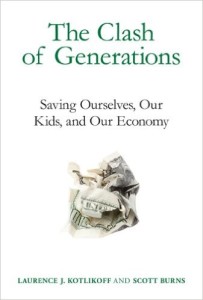Scott Burns and Laurence J. Kotlikoff wrote The Clash of Generations: Saving Ourselves, Our Kids, and Our Economy, thought-provoking and highly readable financial policy book in 2012, featuring four “purple” policy proposals – “purple” meaning meant to appeal to both red and blue sides of the American political spectrum.
In the context of a 2016 Presidential contest featuring the unappealing choice between Know Nothingism (Trump), Socialism (Sanders), Nepotistic Oligarchy (Bush), and Nepotistic Pandering (Clinton),[1] I find it refreshing to read ideas designed to appeal to a broad spectrum of the right and left. Maybe you will too.
Inter-generational screwing
No, I’m not referring to an inappropriate Spring/Winter romance. Rather, Burns/Kotlikoff’s central thesis is that the older generation has – through a combination of tradition, neglect, and the compounding affects of fiscal policy – doomed the younger generations to financial deterioration and eventual financial wipeout.
Intergenerational burden
One of my favorite illustrations of the inequality between generations is the example of seniors gathering for a “Senior Coffee” breakfast at a McDonalds, featuring 55 cent coffee and $1 specials. It initially sounds innocuous.

However, with an average senior’s monthly Social Security check of $1,172, the authors point out that the average McDonald’s worker has to put in 1,172 hours (at $8.00/hour, that’s a 50 cent payroll tax from worker, and a 50 cent payroll tax from employer going to the Federal Government) to generate enough tax revenue for a single senior’s monthly check. With the typical Mcdonalds worker putting in 120 hours per month, it takes almost 10 minimum wage McDonalds workers to support each senior. We don’t usually view the different generations at odds this way, but that’s the kind of intergenerational burden the authors are talking about.
When they run through the runaway increases in federal health care costs [Medicare, plus increased prescription drug reimbursements (W Bush) and the Affordable Care Act (Obamacare)] in addition to unequal tax treatment, the ‘clash of generations’ seems both unfair and unsustainable.
This crisis sets up the background to their main four policy proposals.
Purple Policies
I like this book a lot, and their purple policies deserve to be part of any serious fiscal policy conversation (although which leaders would have that conversation, I’m actually not sure, such is our political discourse these days). I suspect the authors would have their own doubts about the political viability of their somewhat radical solutions, but would argue that the risks of inaction are too great, given the impending fiscal insolvency.
I’ll briefly describe below their four big policy ideas, with links to their further thoughts online.
Finally, after reviewing their policy ideas, I have one critique of the tone of the book’s early chapters.
Purple policy #1 – Limited Purpose Banking
Kotlikoff and Burns advocate a radical simplification of banking functions. Their proposal says that any and all banks (plus insurance companies, brokerages, credit unions, private equity firms) must fund themselves and be regulated as “mutual funds,” taking in actual deposits for every dollar invested in loans. No borrowing, full stop. Any company that prefers to leverage itself (hedge funds might want to) must operate under a “full-liability” regime, meaning losses are guaranteed personally by the business owners and executives. You can see why this is kind of appealing in the wake of the 2008 crisis and bailout of Wall Street.
[Incidentally, my own radical ‘purple plan’ addresses this same post-2008 moral hazard problem, but in a different way. My rule is: Any financial firm over a certain size (I don’t know how many would qualify but let’s say the biggest 25 firms, and any that are considered ‘systemically important’) get regulated like public utilities, with massive restrictions on executive pay. Of course, all financial firms are invited to get smaller through divestiture, sales, breakups, whatever, to get under the size limit and become systemically irrelevant. At that point, executives at the newly smaller firms can go back to paying themselves whatever they want. That’s my solution to the problem of “profits get privately enjoyed via executive compensation but any liabilities get socialized” when a systemically important financial institution gets bailed out.]
Purple policy #2 – Health Care
Their plan begins with individual vouchers for everyone for purchasing a basic plan to receive care from a private provider of their choice. Vouchers are individually ‘risk-adjusted,’ meaning documented medical conditions receive larger vouchers. Anybody is allowed to supplement with additional care out of their own pocket. Insurance companies providing standard care cannot deny coverage. For fiscal sanity, however, they advocate a panel of doctors to set strict budgets on the total cost of all federal vouchers, not to exceed 10% of GDP in any year. (death panels!)
Comprehensive health care policy is well beyond my ken to deeply comment on, but I do appreciate their attempt to set limits to how much public money is spent on health-care. Unfortunately there has to be some rationing of costs when we set a limit like 10% of GDP maximum. I know this a politically radioactive (again, death panels!) but seems like an important adult conversation to engage in.
Since tax policy is arguably the most important and least understood part of public policy, I appreciate the authors’ radical approach here.
For starters, they eliminate personal and corporate income tax (whoa!), which they argue is surprisingly regressive in its current form.
They replace it with a high 17.5% federal retail sales tax, as well as a tax on all consumption above $5,000 done abroad (to catch up you folks running over to Canada to do your shopping, to avoid the high retail tax).
To correct the regressive nature of consumption taxes, they would include a monthly ‘demogrant,’ effectively a transfer to all households, based on family composition, and meant to alleviate the sales tax burden (get to net zero tax) on families below the poverty line.
Estate Taxes in their plan
Interestingly (since I think estate taxes should be discussed more frequently) they would eliminate the federal estate tax, and replace it with a 15% inheritance tax above $1 million. The effect there, I think, would be to encourage estate planning that involves a greater number or recipients. If you had $10 million to pass to heirs, for example, and could pass it on tax free as long as recipients only got $999,999. I think lots of people would choose ten recipients, rather than pay 40% on amounts over 5.43 million (so, $1.828 million in taxes) when giving to a smaller number of heir under the current system. The effect is a wider distribution of inheritance, which is a reasonable goal for addressing intergenerational wealth transfers.
Purple Policy #4 – Social Security Plan
Burns and Kotlikoff address the problem of our unsustainable unfunded social security liabilities, and argue that funding retirement with real worker contributions (through a Personal Security Account PSA) is a necessary replacement system. Workers under age 60 would fund their accounts with a mandatory contribution of 8% of wages. Funds would be invested by the government, at zero cost, in global securities. The federal government would match contributions by the poor, disabled, and unemployed on a progressive basis.
My favorite part of their plan is that retirement benefits get invested in global market-weighted indexes of stocks and bonds. This may sound ‘risky’ but really isn’t, although its easy to find online critiques of their privately-funded plan to replace the defined benefit plan of Social Security.
In any case Burns and Kotlikoff argue there should be a government guarantee of at least a ‘zero real return’ for individuals, which seems like a reasonable solution to the fact that some people will find investing in global securities ‘too risky.’
I’ve skipped many of the details of each of their four policy plans, including quite a few specific provisions to address problems that would arise in the process of shifting from our current system to their radical purple solutions.
I’ve linked above to each of their plans because if you’re a policy nerd, you might enjoy reading through their radical and thoughtful solutions to pressing financial problems.
Ok, now one critique of their book.
A problematic first three chapters
I don’t particularly like their first few chapters, in which they lay out their alarming financial thesis in warnings bordering on Chicken Little-style.
The tone seems intended to strike extreme notes about our future financial doomsday.
- The younger generation is getting financially screwed by the older generation! [2]
- Fiscal deficits are forty times worse than anything the federal government reports!
- Unless dramatic, politically impossible steps are taken soon (and they wont be!) the United States economy will sink into a morass worse than Greece! [3]
Specifically, they note that official estimates of government deficits systematically undercount unfunded public liabilities – for health care and social security in particular – and that the unchecked growth of these liabilities, in the long run, will completely overwhelm the United States’ economy. The losers in this scenario won’t be old folks today, but rather their grandchildren, who inherit the public liabilities. I believe this basic premise, and I believe it’s important to point out, but I guess I don’t like some of the hyperbolic ways its presented, and I don’t think the use of big future numbers tracking deficits is carefully interpreted.
One of the things I’ve noticed when describing compounding effects on money with long time periods is that you can quickly get into overwhelmingly large numbers. I have even done this trick myself in the service of making a dramatic point, but because it combines assumptions about an unknowable future with compounding effects, it’s not hard to mislead readers in the service of a particular thesis.
Between them Kotlikoff and Burns have written and published many serious books (and I have published precisely zero books, serious or otherwise, so what do I know?) but the tone of these first chapters struck me as BIG PUBLISHER driven.
“Make sure you make the case to the reader in Chapter One that everything will go to hell unless people buy this book and also legislators make the policy changes you advocate,” seems to have been the mandate handed down by BIG PUBLISHER.[4]
One problem with this tone is that, if the sky does not fall, and three years have since passed (the book came out in 2012) their dire warnings begin to look less true in retrospect. Or, even if true, (and FWIW I trust the economics behind their warnings) the consequences are less imminent or less dramatic than claimed.
Anyway, what I really mean to say is, their book is much better than the tone of their initial chapters would suggest.
[1] And those are just the leading candidates. Further down the ballot we get financial policies such as Fundamentalist Christianity (Carson, Huckabee), Fire Everyone (Fiorina), Shut Down Government (Paul), Shut Down Government And Burn All The Buildings Too (Cruz), Personal Bankruptcy At Any Moment Now (Rubio), Bully Everyone But Especially Unions (Christie), and I’m Just An Average Joe Son Of A Coalminer From Hellhole Scranton (Biden). And finally for completeness’ sake, I have no idea what they think about financial policy (Chafee, O’Malley, Pataki, Graham, Kasich, Jindal, Santorum).
[2] Somewhat charmingly, both authors are of an age eligible for social security, so they are really writing and advocating against their own self-interest, narrowly understood. If this book was written by a twenty-something, complaining about how the US financial system unfairly favors older people at the expense of younger people, it would read more as a call to intergenerational conflict by the aggrieved youth.
[3] This is the jacket cover language: “The United States is bankrupt, flat broke. Thanks to accounting that would make Enron blush, America’s insolvency goes far beyond what our leaders are disclosing. The United States is a fiscal basket case, in worse shape than the notoriously bailed-out countries of Greece, Ireland, and others.” None of these sentences are objectively true, at all.
[4] The publisher is academic, MIT Press, so its not really BIG PUBLISHER in any obvious sense. But still, the early tone feels marketing driven.
Post read (266) times.







